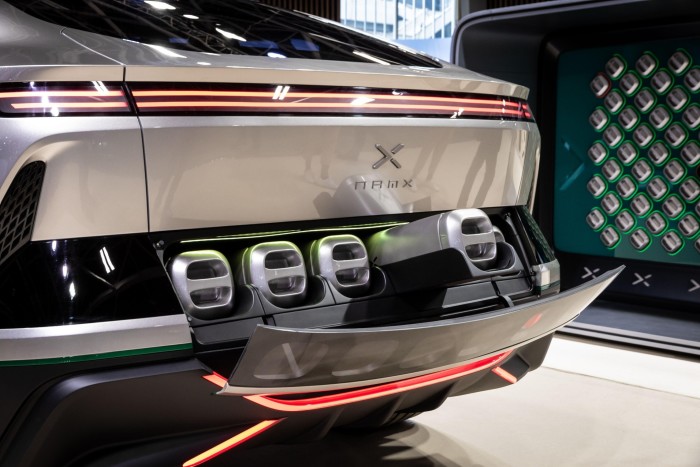Morocco’s carmaking sector revs up for EV era

Roula Khalaf, Editor of the FT, selects her favourite stories in this weekly newsletter.
If Faouzi Annajah has his way, the first hydrogen-powered SUV will roll off a Moroccan production line sometime in 2027. And the fact that a French-Moroccan entrepreneur, still just 30, can even contemplate such a feat shows how far the Moroccan car industry has come in a short time.
In 2010, when Annajah, co-founder of carmaker NamX, was still at school, Morocco produced fewer than 60,000 cars. Last year, despite interruptions to the supply chain during the Covid pandemic, production reached a record 465,000 — neck and neck with Poland, according to CEIC, a data company. Eventually, the government aims to produce up to 1mn cars a year.
But more important than the headline number of vehicles made in Morocco, most of which are sold in Europe, is the kingdom’s success — through a combination of stick and carrot — in forcing the backward integration of its automotive supply chain. There are now more than 250 automotive suppliers, many of them subsidiaries of foreign companies, in the country, employing some 220,000 people.
Although the most sophisticated parts of a car — notably the power train — still need to be imported, many other components, including electronics, seats, axles, windscreens and interiors, can be made in Morocco. NamX aims to source 50-60 per cent of its HUV (“hydrogen utility vehicle”) in Morocco, though the hydrogen canisters it will use will need to be imported, as will the engine — at least at first.

Last year, Renault said it was sourcing more than 60 per cent of parts for its vehicles, the bulk of which are exported, in Morocco. It has pledged to raise that ratio to 65 per cent.
“Now, it’s very much easier to produce a car in Morocco than it was 10 years ago,” says Annajah. Not only does it have a competitive cluster of auto suppliers and OEMs (original equipment manufacturers), he notes, but it is also producing a steady stream of homegrown engineers, with 3,500 working in Casablanca alone, many of them women.
Last year, Moroccans themselves bought 161,000 new cars, with imports coming from Germany, Spain, Czechia and Turkey. The bulk of the 465,000 vehicles produced in Morocco were sold to France, Italy and Spain.
Arguably the biggest breakthrough for the industry, however, came in 2012. That was when Renault started producing cars at a Tangier plant close to the Tanger Med industrial complex and a few miles from Spain. Despite its proximity to Europe, wages here remain about a quarter of the western European level and below those in eastern Europe. The Tangier plant, which has a capacity of 400,000 vehicles, also benefits from tax breaks.
Four years ago, in 2019, Peugeot, now part of Stellantis, followed Renault’s lead. It opened a plant at a cost of nearly $600mn in Kenitra, near Rabat, with a capacity of 200,000 vehicles. Last November, Stellantis, which makes the Peugeot 208 at the plant, said it would invest a further €300mn to double production to 400,000.
“We have succeeded in positioning Kenitra as a leading Stellantis industrial site,” said Samir Cherfan, chief operating officer of Stellantis Middle East and Africa, at the time of the announcement.
Aside from achieving further growth in local supply chains, the next challenge for the industry will be adapting quickly enough to changing regulatory conditions — particularly the EU’s ban on the sale of most internal combustion engine vehicles from 2035.
Renault said it would start to produce two-seater super-mini electric vehicles in Morocco this year. The Dacia brand, acquired by Renault in 1999, will also produce its next-generation Sandero, a 100 per cent battery electric vehicle, in the country.
Last year, Renault signed a memorandum of understanding with Morocco’s mining group Managem to supply 5,000 tonnes of cobalt annually for electric and reusable batteries.
Stellantis’s new line-up will offer small, low-cost automobiles based on its so-called “Smart Cars” platform aimed principally at emerging markets, including electric vehicles. It will also boost the production and assembly of electric quadricycles for the Citroën and Opel brands.

Morocco is now angling for an electric battery plant. In May, following more than a year of negotiations, the government signed a memorandum of understanding with Chinese-German electric vehicle battery giant Gotion High-Tech for the intended construction of Africa’s first gigafactory. Africa Risk Consulting estimated the deal to be worth $6.3bn. As yet, the plant has no scheduled construction date, suggesting the project has not yet been secured.
That signing was followed last month by an announcement from China’s CNGR Advanced Material about a planned $2bn investment to build a cathode materials plant in Morocco, intended to supply the US and European battery markets.
Analysts at advisory group ARC said in a note that the agreement in principle “suggests that Morocco is solidifying its position as Africa’s largest auto-manufacturing hub and is moving assertively to maintain that position for the next generation of EVs (electric vehicles)”.
NamX’s Annajah wants to go one step further, though. Despite the lack of hydrogen infrastructure, NamX is going straight to hydrogen power. The company’s HUV design incorporates six interchangeable hydrogen tanks that, the company says, give the vehicle a range of 800km.
A prototype of the vehicle, made by Italian car design company Pininfarina, was presented at last year’s Paris Motor Show. So far, NamX has recruited 100 engineers, but Annajah says the company will need at least €1bn to bring the car to production. He is currently scouting potential manufacturing sites in Morocco.
A made-in-Morocco hydrogen vehicle in the very early stages of financing may seem far-fetched. Nevertheless, Annajah can take comfort in a piece of history. One critical element of the lithium-ion batteries that underpin the EV revolution is the graphite anode, which provides the battery’s negative pole. Its inventor is a scientist called Rachid Yazami. And he is Moroccan.

Comments